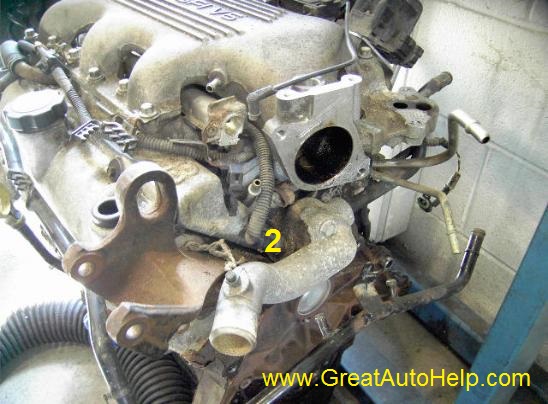

But if the heater core is leaking (or a hose connection to the heater core is leaking), coolant will be seeping out of the bottom of the HVAC unit and dripping on the floor inside the passenger compartment. It is out of sight so you cannot see a leak directly. Heater Core - The heater core is located inside the heating ventilation and air conditioning (HVAC) unit under the dash. On V6 and V8 blocks, the plugs are most easily inspected from underneath the vehicle. The flat steel plugs corroded from the inside out, and may develop leaks that are hard to see because of the plug’s location behind the exhaust manifold, engine mount or other engine accessories.
Coolant leaking from water pump on a gm 3.1 v6 crack#
Sometimes the leak may only occur once the hose gets hot and the pinhole or crack opens up.įreeze plugs - These are the casting plugs or expansion plugs in the sides of the engine block and/or cylinder head. A corroded hose connection or a loose or damaged hose clamp may also allow coolant to leak from the end of a hose. A hose leak will usually send a stream of hot coolant spraying out of the hose. Hoses - Cracks, pinholes or splits in a radiator hose or heater hose will leak coolant. Pinch hoses to check for age cracks, hardening, soft spots, blisters or bulges. If the radiator can’t hold pressure, your engine will overheat and lose coolant. Most cooling systems today are designed to operate at 8 to 14 psi. Internal corrosion caused by old coolant that has never been changed can also eat through the metal in the radiator, causing it to leak. The core itself is also vulnerable to stone damage. On copper/brass radiators, leaks typically occur where the cooling tubes in the core are connected or soldered to the core headers. The seams where the core is mated to the end tanks is another place where leaks frequently develop, especially on aluminum radiators with plastic end tanks. Radiator - Radiators can develop leaks around upper or loser hose connections as a result of vibration. This radiator is badly corroded and is not worth fixing Look for stains, discoloration or liquid coolant on the outside of the water pump or engine. The gasket or o-ring that seals the pump to the engine front cover on cover-mounted water pumps can also leak coolant. If the water pump is a two-piece unit with a backing plate, the gasket between the housing and back cover may be leaking. Water pump - A bad shaft seal will allow coolant to dribble out of the vent hole just under the water pump pulley shaft. The most common places where coolant may be leaking are: You may also notice a sweet smell, which is a characteristic odor of ethylene glycol antifreeze. The color of the coolant may be green, orange or yellow depending on the type of antifreeze in the system. If you suspect your vehicle has a coolant leak, open the hood and visually inspect the engine and cooling system for any sign of liquid leaking from the engine, radiator or hoses. But your car may also have a Low Coolant indicator lamp. The first symptom of trouble is usually engine overheating. Nine out of ten times, coolant leaks are easy to find because the coolant can be seen dripping, spraying, seeping or bubbling from the leaky component.

Coolant leaks can occur anywhere in the cooling system.


 0 kommentar(er)
0 kommentar(er)
